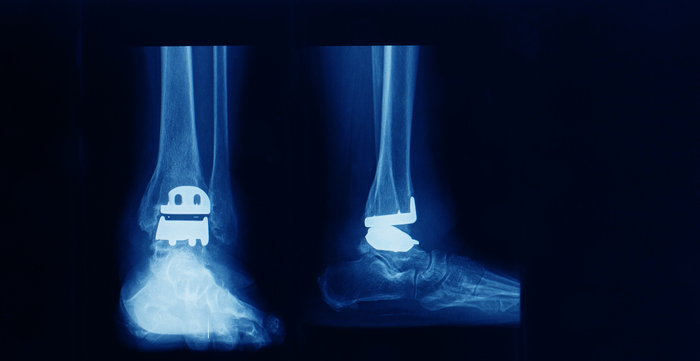Best Ankle Joint Replacement Surgery in Koramangala, Bangalore
Joint replacement surgery is a kind of orthopedic surgery that requires a complex procedure. Doctors recommend joint replacement surgeries to patients suffering from severe orthopedic conditions like arthritis, osteoporosis, osteoarthritis and rheumatoid arthritis.
It is a surgical procedure during which the ends of the affected joint or the damaged bone are removed and are replaced with an artificial joint implant. Joint replacement helps in reducing pain and regaining the joint function.
To seek treatment, you can visit orthopedic hospitals in Bangalore.

What is ankle joint replacement?
Ankle joint replacement is a surgical procedure that involves the replacement of the damaged ankle joint with an artificial implant. The ankle joint comprises three bones: the tibia and the fibula of the leg and the talus of the foot. In medical terms, this joint is called the talocrural joint. The function of the ankle joint is to allow the up-and-down movement of the foot. It acts as a shock absorber while walking.
The procedure is performed under general anesthesia. A surgeon removes the affected part of the joint by making a surgical incision at the affected site. Once the damaged part of the bone is removed, an artificial implant that simulates the joint is placed there.
What are the causes that lead to ankle joint replacement?
Ankle joint replacement is needed by patients suffering from arthritis in the ankles. To know more, you can consult an orthopedic surgeon in Bangalore.
The other common indications for ankle joint replacement are:
- Rheumatoid arthritis
- Post-traumatic osteoarthritis
- Failed Arthrodesis
- Ankle fracture
Those undergoing this surgical procedure should have a good bone density, healthy immune system, normal vascular supply and proper alignment of the ankle and the hindfoot.
Contraindications of ankle joint replacement
The common contraindications for ankle joint replacement surgery are:
- Osteoporosis
- Neurological disorders
- Recurrent infections
- Subluxation of the ankle joint
- Bony deformity of the ankle joint
- Malalignment of the ankle and the hindfoot
What are the symptoms of ankle arthritis?
- Pain
- Swelling
- Stiffness of the ankle joint
- Difficulty in walking
- Reduced joint movement
- Loss of muscle strength
When do you need to see your doctor?
Consult your doctor immediately if you start showing symptoms like severe pain in your ankle joint with signs of redness, soreness and inflammation of the joint. The ankle joint is a load-bearing joint, so if you have difficulty walking or standing, let your doctor know about them. Provide a complete history of your ailment to your doctor. Mention any underlying systemic diseases.
You can request an appointment at Apollo Spectra Hospitals, Koramangala, Bangalore.
Call 1860 500 2244 to book an appointment.
What are the benefits?
Ankle joint replacement surgery is beneficial to people suffering from severe ankle arthritis. Other benefits include:
- There is a reduced risk of developing arthritis of the adjacent joint
- The motion of a patient is also maintained
- Elimination of pain
What are the risks associated with ankle joint replacement?
The common risks associated with ankle joint replacement surgery are:
- Infection at the surgical site
- General anesthesia reaction
- Nerve or blood vessel damage during surgery
- Surgery failure
- Dislocation of the prosthetic joint site
- Clot formation at the surgical site
- Prolonged or excessive bleeding
- Persistent post-surgical pain
Conclusion
Ankle joint replacement surgery is performed by orthopedic surgeons to help and improve joint function by replacing the damaged part of the ankle with prosthetic implant material. A doctor decides whether you need to go for the replacement surgery or not. Consult your doctor for any queries related to this surgical procedure.
The ankle implant used in ankle replacement surgery is made of titanium metal and plastic liner. The metal is placed at the ends of the affected bone and the plastic liner is placed between them to enable hinge-like movement of the ankle resembling a healthy ankle joint.
People with severe deformity of the ankle joint, spongy or soft bone at the joint and dead bone formation in the lower bones of the ankle joint (the talus) and also people with abnormal nerve functions cannot undergo ankle joint replacement. They can instead undergo ankle fusion for pain relief.
A surgeon performs the procedure under general anesthesia or nerve block. A tourniquet is tied above the joint to control bleeding during the surgery. The surgeon approaches the ankle from the front or from the side depending on the site of the implant to be placed. After this, the damaged part of the joint is cut and the metal and the plastic components of the implant are placed ensuring proper alignment of the foot and the ankle. The surgeon then closes the incision site with a few sutures and staples and provides a split to the ankle to aid support while the healing is completed.
Symptoms
Our Top Specialities
NOTICE BOARD
CONTACT US
CONTACT US
 Book Appointment
Book Appointment


.svg)
.svg)
.svg)
.svg)








